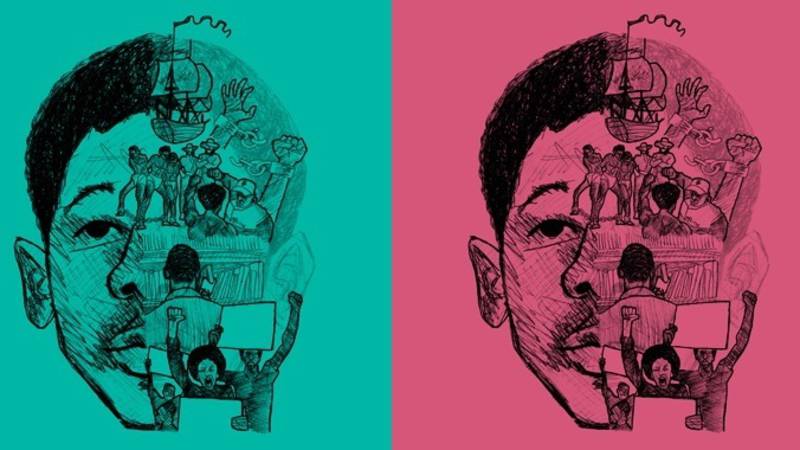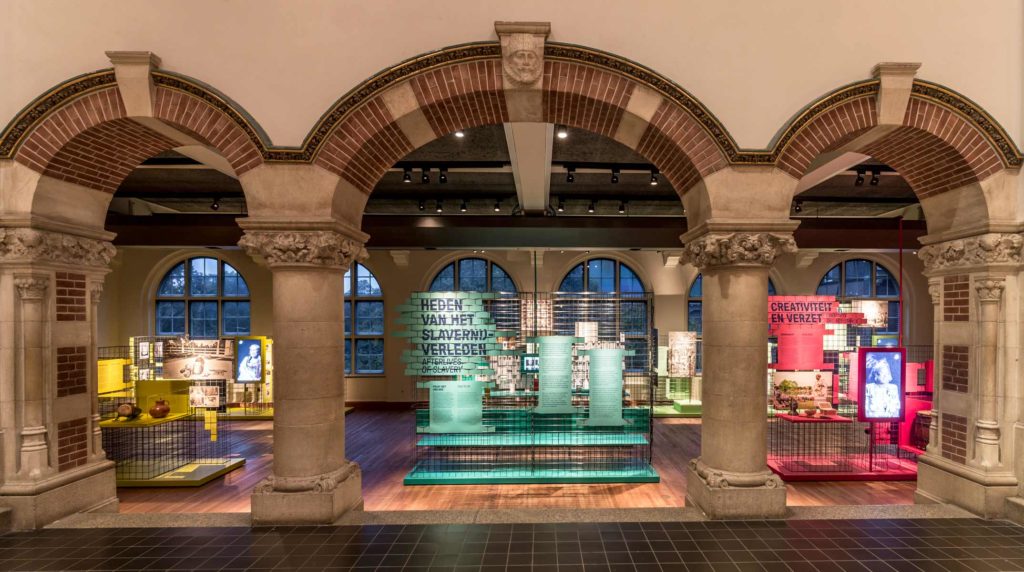Talking about slavery is becoming a more important topic in the Netherlands. Museums are taking part in this conversation by talking about the role the Dutch played and museums become aware of their role in educating society. An example is the exhibition ‘Heden van het Slavernijverleden’ (‘Afterlives of Slavery’) in the Tropenmuseum in Amsterdam.

Courtesy of Tropenmuseum
On the website of the Tropenmuseum it is explained as:
‘The exhibition places the enslaved and their descendants centre stage. To initiate a sometimes difficult but productive dialogue, the Tropenmuseum has sought out personal stories from past and present that bring the history of slavery and its current-day legacies up close. The objects on display from the Tropenmuseum’s collection – tangible relics of the history of slavery – serve to intensify the experience’.
What the Tropenmuseum aims to do
The exhibition aims to emphasise the struggle that the descendants of the enslaved feel in present-day society. They are starting a dialogue between these descendants and other people in society to create a better understanding for the feelings of the aftermath of slavery. The exhibition is developed by Richard Kofi, Wayne Modest and Martin Berger who have devised it and worked it out. They have been advised by The Black Archives who collected critical literature and quotations about slavery and colonial systems. The idea of the display is that the visitor can walk in from three ways, namely through the sides of commemoration, the colonial past and the making of racial discrimination. The most objects come from the museums own collection, but visitors can also contribute by presenting objects which can temporarily become part of the showcase.

Courtesy of Tropenmuseum
This corresponds to what we call a participatory museum. Nowadays museums involve the public more in setting up an exhibition in both content and design. We can recognise this in the aspects that people can present objects for display and through the collaboration with scientists, activists and artists. These people are telling stories about the history of slavery and ask questions to make visitors think.
Creating awareness
In the ‘Heden van het Slavernijverleden’ exhibition the information mainly comes from minority groups and visitors of the Keti Koti festival and the Afrikamuseum in Berg en Dal.
‘The makers consciously opt for a black perspective. “We explain that a certain logic caused people to do very nasty things, but also that there was a sense of agency among enslaved persons to resist and disrupt that imposed order.”‘ ~ Richard Kofi
When you walk into the exhibition the first thing you see is displays being divided into three subjects so the visitor can get a good understanding about how the past was formed and how it still is showing in contemporary life. These stories give the message that in the Netherlands there is not enough education in primary and secondary schools about the history of slavery. The consequence is that society is not well informed and will keep thinking in stereotypes because our perception of history is too narrow. The makers of the exhibition reached their goal of making the audience conscious and understanding the black perspective. Almost all visitors are positive towards the exhibition. They feel it is important to know what happened as not enough people do, and we should pass this knowledge on and prevent this from happening again.
Courtesy of Tropenmuseum
Courtesy of Stichting Herdenking Slavernijverleden 2013 and the Amsterdam Museum
From ‘slaves’ to ‘enslaved people’
Last year ‘Words Matter’ was published which is a lexicon for the museum world about which words are controversial and why. In this publication they also presented alternative words. By explaining that a lot of words arose under colonialism, and thus date from the emergence of racial science in the nineteenth century, they create stereotypes and racism. These terms create a separation between ‘us’ and ‘them’ because by labelling people we realise an exclusion of certain people who will be even more separated from others. The Tropenmuseum therefore stopped using terms as ‘slaves’ and changed it in ‘enslaved people’. While the Tropenmuseum aims to avoid the question of blame and penance it is still slightly showing through certain words. When you are trying to give the black perspective a better place in society, and change words that are common to white people, you are indirectly putting guilt on those white people. This is also an aspect of negative feedback, namely the visitor sees only a small part of the story and the use of words implicate that Europeans are to blame for what happened. This can result in the exclusion of a certain audience, so you still don’t reach your goal of educating everybody.
Conclusion:
In 2021 a new elaborate exhibition will open about ‘Slavernij & Nederland’ (‘Slavery & the Netherlands) in the Tropenmuseum which is looking at the heritage of the colonial past. The museum will work together with ‘sounding board groups’, experts from minority groups and activists. Although the current exhibition succeeds in presenting an informative black perspective on this topic, it is also important to give space to the white perspective. Otherwise an ‘us’ versus ‘them’ perspective remains. This can also lead to a reverse feeling of exclusion for white people which can reduce their empathy for the black perspective. Therefor it is important to bring both perspectives in one exhibition so it can create a dialogue. Only by creating this space we can try improving the elimination of stereotypes and discrimination.
Manon Tietzel
Further reading:
S. Desmarais, L. Bedford, and H. J. Chatterjee, H.J., Museums as Spaces for Wellbeing: A Second Report from the National Alliance for Museums, Health and Wellbeing (2018).
Editor, ‘’Waarom zo opgefokt?’’, De Telegraaf, 21-10-2017.
Gertjan van Schoonhoven, ‘Stijn Schoonderwoerd: ‘Ik bepleit de radicale nuance’’, Elsevier weekblad, 19-06-2019. https://www.elsevierweekblad.nl/nederland/achtergrond/2019/06/ik-bepleit-de-radicale-nuance-173058w/